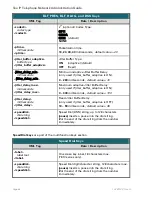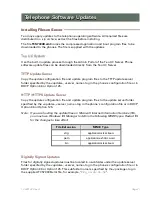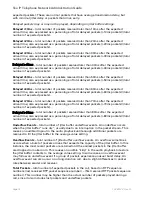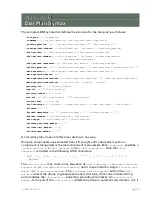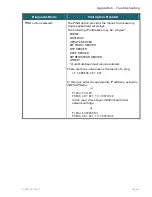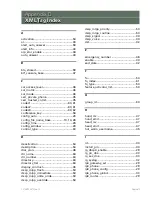
13-280132 Rev. Q
Page 75
The complete BNF syntax that defines the structure for the dial plan is as follows:
<
dial_plan
> ::= <component>*
<
componen
t> ::= <prefix-operation> <dial-pattern> <suffix-operation>
<
prefix-operation
> ::= “{“ <subst-pattern-element>* “|” <dial-character>* “}”
<
subst-pattern-element
> ::= <dial-character> | <wildcard> | <bracket-expression>
<
dial-pattern
> ::= <dial-pattern-element>+ [<dial-pattern-terminator>]
<
dial-pattern-element
> ::= <dial-character> | <wildcard> | <bracket-expression>
| <secondary-dialtone-marker>
<
dial-pattern-terminator
> ::= <initiate-call-marker> | <block-access-marker>
<
suffix-operation
> ::= “{“ <subst-pattern-element>* “|”<dial-character>* [<meta-operation>] “}”
<
meta-operation
> ::= <meta-operation-marker> <meta-operation-identifiers>
<
meta-operation-marker
> ::= “`”
<
meta-operation-identifiers
> ::= <meta-operation-identifier> [“,” <meta-operation-identifier>]
<meta-operation-identifier>
::= <priority-id> | <rph-id> | <cal-id>
<priority-id>
::= “P” <priority-index>
<rph-id>
::= “R” <priority-index>
<priority-index>
::= (0 to 49)
<cal-id>
::= “CF” <access-level> | “CV” <access-level>
<
access-level
> ::= (0 to 99)
<
dial-character
> ::= <numeric> | <upper-case-alpha> | <lower-case-alpha> | <dial-symbol>
<
wildcard
> ::= “^”
<
bracket-expression
> ::= “[” <bracket-element> { “,” < bracket-element > } “]”
<
bracket-element
> ::= <dial-character> | <dial-range>
<
dial-range
> ::= <dial-character> “-“ <dial-character>
<
secondary-dialtone-marker
> ::= “`”
<
initiate-call-marker
> ::= “#”
<
block-access-marker
> ::= “!”
A null <dial_plan> does not affect user dialing in any way.
Dial plan components are evaluated from left-to-right until a dial pattern within a
component is recognized or the last component is processed. Each
<component>
specifies a
<prefix-operation>
, a
<dial-pattern>
, and a
<suffix-operation>
. Note that
<dial-
character>
is limited to the following ASCII characters:
A-Z a-z 0-9 . @ _ - / \, : ; * ‘ “ ( ) < > ~ + = ? ! $ % &
(space)
The
<dial-pattern>
may contain any sequence of
<dial-character>,
<wildcard>,
<
bracket-
expression>
, or
<secondary-dialtone-marker>
, and it may end with a single
<initiate-call
marker>
or
<block-access-marker>
. The
<secondary-dialtone-marker>
within the
<dial-
pattern>
directs the phone to generate secondary dial tone, if the current dialed string
entry matches the
<dial-pattern>
sub-string preceding the marker. An
<initiate-call-
marker>
at the end of the
<dial-pattern>
directs the phone to automatically initiate a call, if
A
A
A
p
p
p
p
p
p
e
e
e
n
n
n
d
d
d
i
i
i
x
x
x
B
B
B
D
D
D
i
i
i
a
a
a
l
l
l
P
P
P
l
l
l
a
a
a
n
n
n
S
S
S
y
y
y
n
n
n
t
t
t
a
a
a
x
x
x
Summary of Contents for 4101
Page 6: ...Teo IP Telephone Network Administration Guide Page 6 13 280132 Rev Q ...
Page 16: ...Teo IP Telephone Network Administration Guide Page 16 13 280132 Rev Q ...
Page 18: ...Teo IP Telephone Network Administration Guide Page 18 13 280132 Rev Q ...
Page 23: ...XML Configuration Files 13 280132 Rev Q Page 23 ...
Page 24: ...Teo IP Telephone Network Administration Guide Page 24 13 280132 Rev Q ...
Page 70: ...Teo IP Telephone Network Administration Guide Page 70 13 280132 Rev Q ...
Page 72: ...Teo IP Telephone Network Administration Guide Page 72 13 280132 Rev Q ...
Page 86: ...Teo IP Telephone Network Administration Guide Page 86 13 280132 Rev Q ...


